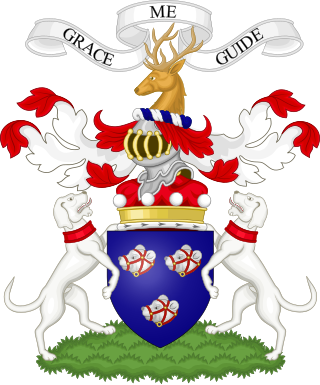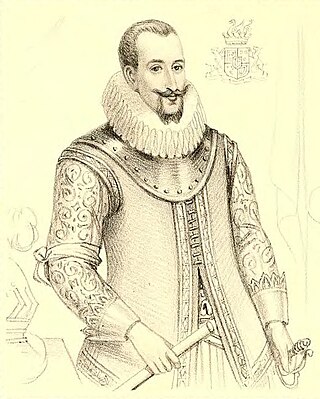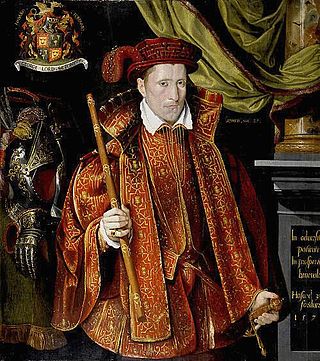Related Research Articles
James Hamilton, 1st Earl of AbercornPC (S) (1575–1618) was a Scottish diplomat for James VI and an undertaker in the Plantation of Ulster, Ireland.

John Maitland, 1st Duke and 2nd Earl of Lauderdale, 3rd Lord Maitland of Thirlestane KG PC was a Scottish politician and leader within the Cabal Ministry.

Archibald William Montgomerie, 13th Earl of Eglinton, 1st Earl of Winton, KT, PC, styled Lord Montgomerie from 1814 to 1819, was a British Conservative politician. He was Lord Lieutenant of Ireland in 1852 and again from 1858 to 1859.

Earl of Eglinton is a title in the Peerage of Scotland. It was created by James IV of Scotland in 1507 for Hugh Montgomerie, 3rd Lord Montgomerie.

Lord Forbes is the senior Lordship of Parliament in the Peerage of Scotland.

Claud Hamilton, 1st Lord Paisley was a Scottish nobleman who fought at the Battle of Langside in 1568 for Mary, Queen of Scots. He is the ancestor of the earls, marquesses and dukes of Abercorn.
Extraordinary Lords of Session were lay members of the Court of Session in Scotland from 1532 to 1762, and were part of the historical judiciary of Scotland.

Clan Maitland is a Lowland Scottish clan.

John Maitland, 1st Lord Maitland of Thirlestane, of Lethington, Knight (1581), was Lord Chancellor of Scotland.

Sir Alexander Seton, 1st Viscount of Kingston, a Cavalier, was the first dignity Charles II conferred as King.

Robert Seton, 1st Earl of Winton was one of the Scottish peers who supported Mary, Queen of Scots.
Robert Seton, 2nd Earl of Winton and 9th Lord Seton was a Scottish Peer.

George Seton, 3rd Earl of Winton was a notable Royalist and Cavalier, the second son of Robert Seton, 1st Earl of Winton and 6th Lord Seton, by his spouse Margaret, daughter of Hugh Montgomerie, 3rd Earl of Eglinton.
George Seton, 3rd Lord Seton, of Seton, East Lothian, was a Lord of Parliament, Lord Auditor, and a Scottish ambassador.
John Maitland, 1st Earl of Lauderdale, Viscount of Lauderdale, Viscount Maitland, and Lord Thirlestane and Boltoun, was President of the Parliament of Scotland as well as the Privy Council, a lawyer and a judge, who sided with the Parliamentarian cause during the Civil War.
George Seton IV, 6th Lord Seton was a Lord of the Parliament of Scotland.

George Seton V, 7th Lord Seton (1531–1586), was a Lord of the Parliament of Scotland, Master of the Household of Mary, Queen of Scots, and Provost of Edinburgh. He was the eldest son of George Seton, 6th Lord Seton, and Elizabeth Hay, a daughter of John Hay, 3rd Lord Hay of Yester. His childhood and schooling were in France.
Elizabeth Gordon, Heiress of Gordon, Scottish baroness and progenitress of the Gordon Earls and Marquesses of Huntly.
Alexander Seton, Lord Gordon was a Scottish baron, Lord of Parliament and progenitor of the Gordon Earls and Marquesses of Huntly.
The Decreet of Ranking of 5 March 1606 determined the relative precedence of members of the peerage of Scotland.
References
- ↑ Brown, Peter, publisher, The Peerage of Scotland, Edinburgh, 1834: 213
- ↑ Anderson, William, The Scottish Nation, Edinburgh, 1867, vol.viii: 437
- ↑ Cokayne, G. E., and White, Geoffrey H., editor, The Complete Peerage, London, 1949, vol. xi, p. 633
- ↑ Seton, George A History of the Family of Seton during Eight Centuries. 2 vols. Edinburgh, 1896
- ↑ The History of the House of Seytoun to the Year MDLIX", Sir Richard Maitland of Lethington, Knight, with the Continuation, by Alexander Viscount Kingston, to MDCLXXXVII. Printed at Glasgow, MDCCCXXIX
- ↑ Seton, Monsignor, An Old Family, History of the Setons of Scotland and America; Brentano's, New York, 1899.
- ↑ Seton, Robert. An Old Family: Or, The Setons of Scotland and America, Brentano's, 1899, p. 51
 This article incorporates text from this source, which is in the public domain .
This article incorporates text from this source, which is in the public domain .
